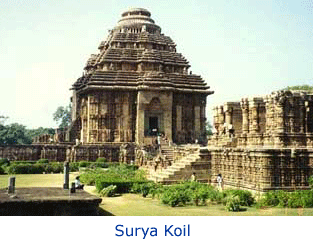 The Sun Temple at Konarak was built in about 1250 AD by
the East Ganga king Narasimhadeva. It is thought he built the
temple to commemorate military successes against
Muslim invaders.
The Sun Temple at Konarak was built in about 1250 AD by
the East Ganga king Narasimhadeva. It is thought he built the
temple to commemorate military successes against
Muslim invaders.
According to local legend, the temple has a great aura of power that comes from two very powerful magnets said to have been built into the tower - magnets that allowed the king's throne to hover in mid-air.
European mariners sailing off the coast used the temple's tower for navigation, but dubbed it the Black Pagoda for the frequent shipwrecks that occurred along the coast. They attributed the disasters to the legendary magnets' effect on the tidal pattern.
Konarak was sacked by the Muslim Yavana army in the 15th century. The central statue enshrined in the temple was smuggled away to Puri by priests, but the Sun Temple was badly damaged in the attack.
Nature took over the destruction from there. Over the centuries, the sea receded, sand engulfed the building and salty breezes eroded the stone. It remained buried under a huge mound of sand until the early 20th century, when restoration began under the British.
British archaeologists uncovered the lower parts of the temple that had remained well preserved beneath the sand and restored what they could of the rest of the ruins. Trees were planted to shelter the temple from the damaging winds and a museum was opened to display whatever sculpture wasn't left in situ or sent to Delhi, Calcutta and London.
In 1924, the Earl of Ronaldshay proclaimed the newly-revealed temple to be "one of the most stupendous buildings in India which rears itself aloft, a pile of overwhelming grandeur even in its decay."



